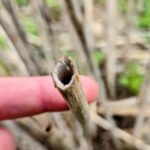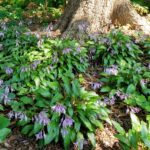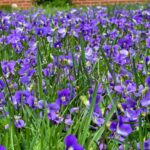Gardeners are bombarded with sayings like save the stems, leave the leaves, and no mow May. These sayings are rooted in the same goal of protecting pollinators, but often leave gardeners with more questions. Let’s dig into each of the sayings.
- Figure 1. In Spring, dead flower stems can be pruned back to heights ranging from 8 to 24 inches.
- Figure 2. Leaf litter used as mulch under trees and around perennials to suppress weeds and retain moisture.
- Figure 3. Wild violets established in the lawn add an early food source for pollinators while decreasing mowing frequency.
Save the stems:
The first question that often arises from this saying is: “When can I cut out and remove the dead stems?” There is not a straight-forward answer and it’s important to understand why it’s recommended in the first place. When left to overwinter, dead flower stalks with their seed heads provide a food source to our year-round residents like the American goldfinch, Tufted titmouse, and Black-capped chickadees. Once spring arrives, dead flower stalks become nesting sites for some of Indiana’s 400+ native pollinators. With such a diverse population, one size (and one temperature) doesn’t fit all. Stalks should be pruned to a variety of heights between 8 and 24 inches in early spring to accommodate a variety of insects. Last year’s cut dead stems become home to larvae throughout the summer and are hidden by the new growth. These same stems will continue to be utilized through next winter for insect larvae and overwintering adults. So yes, gardeners can prune back dead stems now, but more importantly, leave the cut stems standing. They will naturally decompose and fall, hence the saying, “Save the stems.”
Leave the leaves:
There is a myriad of reasons to “leave the leaves.” Leaves act as nature’s mulch; providing nutrients and organic matter as well as protection from Indiana’s unpredictable temperature swings. When it comes to pollinator protection, fallen leaves provide a winter habitat for a majority of our butterflies and moths. Gardeners are often left wondering, “When can I remove the leaves?” Ideally, never, but if leaving the leaves is not a permanent option, it’s best to let them lay until late spring. Leaving them untouched through May provides ample opportunity for hibernating insects to emerge. In landscapes where leaving the leaves isn’t an option, consider raking leaves for use as mulch around trees, shrubs, and perennials creating an area to “leave the leaves” indefinitely.
No Mow May:
This catchy phrase is rooted in good intentions of protecting pollinators and reducing carbon emissions. However, these benefits will only apply if there are wild flowers in the lawn. A solid turfgrass lawn, void of low growing flowers, will not provide benefits to pollinators regardless of how tall it gets. If turfgrass is left to grow through May, more mowing may be needed in June to compensate, contributing to an increase in carbon emissions. As some are beginning to understand the impracticality of a “no mow May,” the saying “low mow May” has emerged. Let’s counter that with a “low mow lawn.” Instead of focusing on one month, consider making a low mow lawn year-round.
If the goal is to provide direct benefits for pollinators, there is a clear way to achieve a low-mow lawn. Encourage or establish low growing wildflowers, instead of turfgrass. A “weedy lawn” filled with clover, violets and dandelions provides a food source for pollinators and reduces mowing frequency. If a manicured turfgrass is required, but there’s still desire to protect pollinators, take steps to reduce mowing frequency and chemical inputs. Lawns that are 3 inches or taller are more resistant to weeds decreasing the need for herbicide applications. Utilizing a mulching lawnmower returns nutrients from grass clippings and decreases the amount of chemical fertilizer needed. While one method provides direct benefits and the other minimizes harm, both provide pollinator protection.
Ultimately, pollinator protection should not be considered an all-or-nothing endeavor. Save the stems that don’t get in the way, leave the leaves where appropriate, and mow only when needed.
Further resources
Purdue Pollinator Protection series – https://extension.entm.purdue.edu/publications/pubs/PollinatorProtection.html
Xerces Society for Invertebrate Conservation – https://www.xerces.org/
Purdue Turf Science: 7 Simple Steps to a Better Home Lawn – https://www.extension.purdue.edu/extmedia/AY/AY-32-W.pdf


